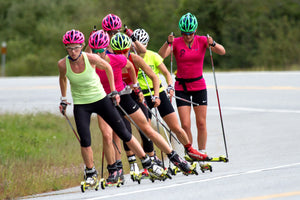Coaches Corner- Into to Roller Skiing
June 13, 2022
2 Comments

Intro to Rollerskiing Top Tips
For serious Nordic skiers May and June mean the start of hearing the "click, click" of poles tips on asphalt amidst birds singing and blooming flowers. Roller skiing isn't just for top athletes however. It is a great way to stay in touch with the skiing muscles and even improve balance, timing, and technique for the enthusiast skier all year round. When snow arrives, the technique feels very confident.
The catch is with the word “snow”. Hardpack snow isn’t pavement and doesn’t feel the same when gliding on top of it, or…well, connecting with it. As in, falling.
Moving well on rollerskis is so like being on snow that it is easy to get lulled into thinking one can hockey stop if a hazard arises. Nope. Here’s some top tips and awareness points for those getting started.
- Falling happens. Falling on snow happens, falling off a bike happens. Rollerskiing is no different. But should be rare.
- Learn and practice the different methods of slowing and stopping, as they’re not the same as snow. The rollerski snowplow looks similar to snow but is done differently. Just like braking on a car in snow is different and takes more distance to accomplish, braking on rollerskis requires more distance.
- Preview any new venue and re-assess regular venues after rain. Keep in mind your personal ability to slow down and brake. Wet weather will add distance to your stopping, and rain can flush new gravel and debris onto an otherwise familiar course.
- Beware gravel! Far worse than the spring snow phenomenon of hitting a sudden slow section, a piece of gravel (or twigs or small pine cones) hit dead on will stop a rollerski. Not a problem for the rollerski, but the rollerskier doesn’t stop until they hit the pavement!
- Keep your tips sharp. Only poles with carbide steel tips will grip on asphalt, and they should be kept sharp. Regular files won’t do the job, get a small diamond file and apply regularly. While most all high-performance poles have carbide tips, for frequent rollerskiing it is often much better to replace the light duty winter baskets with a rollerski specific tip.
- Check the tightness of axle bolts and binding screws occasionally. For frequent users a cool trick is to mark one ski after each use as R or L, and next time be sure to use on the other foot; this will even the wear and delay the eventual wheel replacement.
- For classic rollerskiing it is recommended that having coaching feedback is wise, in that the grip from the rollerski ratchet is different from the grip from classic skis and can lead to bad habits.
- Skate rollerskis are different in that the feedback is more often positive and can be more beneficial than snow skis. This intrinsic feedback from skate rollerskis becomes your personal coach! If movement feels free and easy you’re likely skiing well. If something doesn’t feel right, it is because it isn’t!
- Take it slow. Arguably the most transferable and safest technique to practice on roller skiing is a basic double pole.
Helmets? Check. Gloves? Check. Now get out there!
2 Responses
Leave a comment
Comments will be approved before showing up.

Glenda Culbertson
June 27, 2022
Please add me to the Sunday roller ski group email… my email to Kelly is not going through… I probably have the wrong address